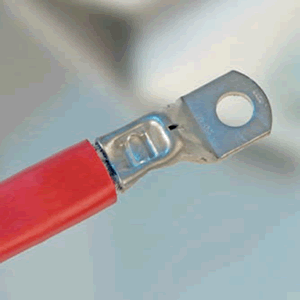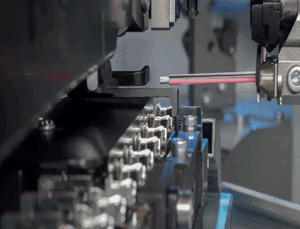Aluminum: The Wiring Material of the Future
Lightweight aluminum wiring can replace heavier copper wires in the wiring harness, but aluminum is a demanding material. TE suggests considerations that could help make aluminum the wiring material of the future.

Proven during extensive use: COPALUM crimp connector for contacts with aluminum conductors.
Aluminum is a good conductor of electricity. In the car industry, this lightweight material is in the process of replacing copper in power cables. There are two key advantages in using aluminum – lower material costs and considerably less mass than copper. If aluminum wiring is used, a wiring harness in a mid-sized vehicle can shed up to six pounds of “fat,“ which trims fuel consumption and CO emissions. Aluminum can score points even in vehicles with alternative drive trains (hybrid and electric vehicles) by helping extend the range of travel possible in electric driving mode.
Three Questions to Consider
The wiring harness is one of a vehicle’s heaviest components. Lightweight aluminum wiring can replace heavier copper wires in the wiring harness, but aluminum is a demanding material. To ensure reliable electrical contacts over time, the connector technology must be designed specifically for stranded conductors made of aluminum. This calls for lots of general knowledge and process expertise.
Familiarity with the Material
Replacing copper conductors with aluminum ones meets key specifications in motor vehicle technology with regard to lightweight design and materials availability. However, along with its strengths, aluminum also has several properties that can make its use as a material for conductors more challenging.
To ensure the highest possible product quality you should ask your supplier:
- Is the company aware of the difficulties aluminum contacts can present?
- Does it know how to set about meeting the challenges involved?
- Is it already experienced in the use of aluminum as a material for electrical contacts?
Preventing Creep
Under mechanical strain, the aluminum alloy tends to exhibit signs of what is referred to as “creep,” at temperatures considerably lower than in the case of copper. That is why aluminum-copper connections need to be established at connection points on the wiring harness in a way that prevents a loss of electrical performance over the life cycle of the product.
Preventing Electrochemical Corrosion
There is a high potential difference between aluminum and copper. As a result, in the presence of moisture, more base aluminum tends to decay at the aluminum-copper connection. Appropriate steps need to be taken to prevent this electrochemical corrosion.
Keep Lower Strength in Mind
The mechanical strength of aluminum is equal to only about one-third of copper. This must be factored in when using it as conductor material if the wires are to achieve a high level of mechanical strength while achieving the necessary retention forces in the connections.
Ensuring Electrical Contact
Aluminum forms a dense and very hard oxide layer that prevents corrosion while insulating at the same time. There must be a reliable way to destroy this oxide layer if there is going to be good electrical conductivity.

TE’s new aluminum-F-crimp allows for fully automated processing with standard machines.
Deep Process Expertise
Fully automated contacts that use aluminum conductors require a well-grounded grasp of the processes involved. A supplier needs to take steps that will reliably ensure lasting aluminum contacts.
To assess a supplier‘s production process and reliability of electrical contacts, you should ask:
- Has the company mastered the production process?
- Is a reliable electrical connection achieved?
- Is there high mechanical tensile strength and corrosion resistance?
- Can the company produce in large quantities?
Reliable Testing and Inspection Methods
The automobile industry has considerable demands when it comes to the reliability of electrical connectors – even more so where the goal of life-cycle durability is concerned. Use of aluminum in vehicle wiring creates high demands for testing within the scope of development and product safety.
If you attach importance to developed and tested quality from a single source, you should ask your supplier:
- Does the company have testing and inspection facilities of its own?
- Does the technology meet the highest standards?
- Do the testing and inspection procedures used deliver absolutely reliable results?
To safely optimize aluminum wiring and contacts in automotive applications, it is essential to find a supplier with recognized materials expertise, a profound process orientation, and extensive inspection and testing competencies.
To read this white paper in its entirety, click here.





